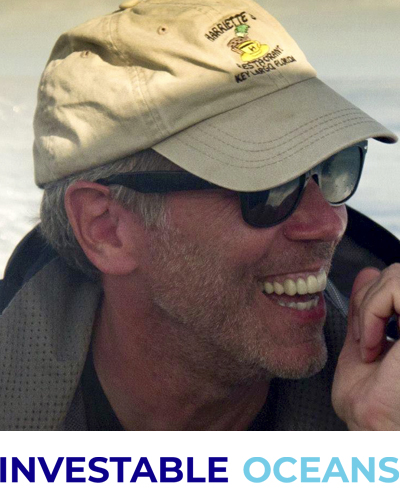
Sustainable Ocean Investing Gets Real: Opportunities Across All Asset Classes
 Above: Shark Reef and refinery, photo by Morgan Bennett-Smith
Above: Shark Reef and refinery, photo by Morgan Bennett-Smith
(First published Sept. 2021) ESG and sustainable investing have taken center stage in asset management. Climate and now oceans are leaders in this elevation with a proliferation of products, firms, and frameworks increasingly on investors’ radar screens. This is good news: the oceans are becoming broadly investable, with market-based opportunities across all sectors of the Blue Economy. These cover the entire asset allocation pie chart – equites, fixed income, private equity and venture capital.
At Investable Oceans, we provide a platform to connect investors and companies across all these sectors and asset classes. Our goal is to simplify and accelerate market-based sustainable ocean investing by centralizing research, commentary, inspiration, and access to blue enterprise in one place. A vital part of our mission is education, which comes in a wide variety of forms including academic research, visual arts, and podcasts to accommodate different learning preferences. We also engage the ocean community extensively through partnerships and participation in numerous initiatives. Going forward, we plan to continue expanding our range of offerings to reach the deepest and broadest investing audience possible.

If you’re wondering whether investing in the Blue Economy applies to you, consider this variety of offerings: an ocean-focused ETF from BNPP; a public equities ocean engagement fund from Credit Suisse and Rockefeller Asset Management; a private equity aquaculture fund from Netherlands-based Aqua-Spark; and a variety of blue bonds from issuers such as the Seychelles and the Bank of China. You can even invest $100 in an Ocean Health portfolio using the Newday Impact Investing app; or $100 in a crowdfunding raise for C-Combinator to help turn the largest seaweed bloom on the planet into valuable materials that combat climate change.
The broader ocean economy is enormous, so the diversity of investment opportunities shouldn’t come as a surprise. The OECD’s often quoted 2016 report, “The Ocean Economy in 2030”, conservatively estimated a $3 trillion ocean GDP by 2030. In addition, a 2015 WWF report estimated the value of key ocean assets to be at least $24 trillion. The Blue Economy is a subset of this broader ocean economy, with the latter capturing all human business activities in the ocean, and the former a narrower slice of activities that utilize the oceans resources in a sustainable manner. The Economist defines the Blue Economy as “An economy that harnesses ocean resources for economic growth while protecting ocean health and ensuring social equity.” In the post-COVID world, both the ocean economy and importantly the Blue Economy are poised to expand as we build back with more awareness of and respect for the natural world.

Achieving a sustainable Blue Economy is critical, as healthy oceans will continue to provide us with food, oxygen, transportation, recreation and climate regulation. Greenhouse gases (GHGs) are the central threat to both our climate and our oceans, contributing greatly to warming, acidification and deoxygenation. The global community is becoming increasingly aware that we can’t fix the climate crisis without addressing the oceans, and vice versa (see the IPCC’s 2019 Special Report on the changing oceans and cryosphere for a compelling argument). And, our key takeaway is this: climate-friendly investments are inherently also investing in ocean health.
Market-based ocean investing focuses on addressing many of these challenges while providing financially attractive opportunities for participants. Importantly, it’s not a replacement for the vital contributions of philanthropy, concessionary impact investments, governments and NGOs – rather, it’s an important complement. Market-based approaches for our blue planet can unlock substantial capital that requires returns comparable to other market-based opportunities. Harnessing these can significantly increase the amount of funding available to attain, for example, the oceans and climate objectives of the United Nations’ Sustainable Development Goals (SDGs) #13 (Climate Action) and #14 (Life Below Water). Some argue that the oceans touch nearly every other SDG, and that positive ocean actions will have enormous benefits for all.
Because there are many facets of the Blue Economy that we don’t have space here to cover – governance, investment frameworks, social justice and gender issues, to name a few – we’ve set up a section on the Investable Oceans website for GreenMoney readers that provides some of the excellent research on the broader topic. These elements are critical for broader context on investing in the Blue Economy.

So what are the investable sectors of the Blue Economy? At Investable Oceans, we use the following five categories: Energy Solutions, Fisheries & Aquaculture, Plastics & Pollution, Shipping & Ports and Tourism. There are other options; for example, some view technology as a separate category. While we agree that technology is critical, we see it expressed across all sectors. We also exclude fossil fuel and deep-sea mining because they don’t seem consistent at this time with the express goal of sustainable ocean stewardship. Investments that involve water are included to the extent that they have a reasonably direct connection to the ocean. For instance, keeping plastics out of the ocean, agricultural run-off and coastal habitat destruction are all represented on the site.
The nature of investments in these five sectors varies. In offshore wind, for example, projects are developed by large corporate players such as Orsted or Equinor, while related supply chain and technology opportunities are available through smaller private enterprises. Fisheries & Aquaculture investments can take place in public or private companies, as well as funds and a dizzying array of startups. For emerging companies, each ocean sector has unique characteristics, and investors often specialize and dive deeply into just one or two.

With respect to asset classes, public equity markets offer opportunities but also require extra work. While there are companies that are clearly ocean related, such as Orsted (offshore wind), Mowi (seafood) and Lindblad (tourism), ocean activities are often embedded in companies that operate along multiple business lines. Recent research efforts have unpacked and analyzed “ocean business” because interest continues to swell. Some notable examples include: “The Ocean 100” (the hundred largest transnational corporations in eight core industries of the ocean economy), the Business for Ocean Sustainability report and UNEP FI’s Turning the Tide: How to finance a sustainable ocean recovery. In-depth studies like these are laying groundwork for an eventual “ESGs for the Seas.” There is still a distance to go, but this is undoubtedly a promising and impactful start.
On the fixed income front, The Ocean Finance Handbook by Friends of Ocean Action provides an excellent mapping of various debt securities to ocean issues. Following in the wake of Green Bonds, “Blue Bonds” are also becoming an exciting emerging asset class, with a wide variety of issuance types recently coming to market. Investable Oceans and DLA Piper, together with other key stakeholders, recently hosted a Blue Bond webinar that provides an overview of this growing and important market. More broadly, structured finance and securitization principles can be found in many investments, often used to facilitate risk-sharing and/or subordinated investments.

Private equity and venture capital play critical roles in financing the Blue Economy. Institutional investment in funds is still in its early stages, partly due to limited track records and smaller fund sizes. Still, there have been numerous compelling fund launches recently, adding to a number of existing funds led by experienced investors. For earlier stage companies, a global innovation ecosystem of well over one hundred incubators, accelerators, clusters and contests is stimulating startup company creation and growth from Oslo to Cape Town to Seattle to Sydney. Organizations like 1000 Ocean Startups and Ocean Visions are bringing together powerful combinations of individuals and institutions to accelerate global change in responsible ocean business and stewardship.
As you can see, the opportunities for market-based sustainable ocean investing are real – it is an exciting time to do good and do well, for our oceans and ourselves.
Article by Ted Janulis, Founder and Principal, Investable Oceans
Ted has served in various executive positions, including CEO, at financial institutions involved in Capital Markets, Banking and Asset Management over a 30+ year business career. He is President Emeritus of The Explorers Club in New York City and currently serves on a number of for-profit and not-for-profit boards, including Gannett Co. Inc., Roc Capital, RiskSpan Inc and Duke University’s Nicholas School of the Environment.
The oceans have been one of Ted’s passions since he was young, and he’s excited to combine this passion with his finance background in launching an oceans investment platform called Investable Oceans.
Energy & Climate, Featured Articles, Food & Farming, Impact Investing, Sustainable Business
Sustainable Ocean Investing: Opportunities Abound in the Blue Economy – Wealth Newsletter Daily
[…] Read Ted’s deeply informative and very useful article here – https://greenmoney.com/sustainable-ocean-investing-gets-real-opportunities-across-all-asset-classes […]
Sustainable Ocean Investing: Opportunities Abound in the Blue Economy – Wealth Creation Investing
[…] Read Ted’s deeply informative and very useful article here – https://greenmoney.com/sustainable-ocean-investing-gets-real-opportunities-across-all-asset-classes […]
Sustainable Ocean Investing: Opportunities Abound in the Blue Economy – Daily Stock Watchers
[…] Read Ted’s deeply informative and very useful article here – https://greenmoney.com/sustainable-ocean-investing-gets-real-opportunities-across-all-asset-classes […]
Sustainable Ocean Investing: Opportunities Abound in the Blue Economy – Bullish Mindset
[…] Read Ted’s deeply informative and very useful article here – https://greenmoney.com/sustainable-ocean-investing-gets-real-opportunities-across-all-asset-classes […]
Sustainable Ocean Investing: Opportunities Abound in the Blue Economy – Daily Market News
[…] Read Ted’s deeply informative and very useful article here – https://greenmoney.com/sustainable-ocean-investing-gets-real-opportunities-across-all-asset-classes […]
Sustainable Ocean Investing: Opportunities Abound in the Blue Economy – Investing Ideas Daily
[…] Read Ted’s deeply informative and very useful article here – https://greenmoney.com/sustainable-ocean-investing-gets-real-opportunities-across-all-asset-classes […]
Sustainable Ocean Investing: Opportunities Abound in the Blue Economy – Hooked On Stocks
[…] Read Ted’s deeply informative and very useful article here – https://greenmoney.com/sustainable-ocean-investing-gets-real-opportunities-across-all-asset-classes […]
Sustainable Ocean Investing: Opportunities Abound in the Blue Economy – Investor Newsletter
[…] Read Ted’s deeply informative and very useful article here – https://greenmoney.com/sustainable-ocean-investing-gets-real-opportunities-across-all-asset-classes […]
Sustainable Ocean Investing: Opportunities Abound in the Blue Economy – Investors News
[…] Read Ted’s deeply informative and very useful article here – https://greenmoney.com/sustainable-ocean-investing-gets-real-opportunities-across-all-asset-classes […]
Sustainable Ocean Investing: Opportunities Abound in the Blue Economy – The Wealthiest Investor
[…] Read Ted’s deeply informative and very useful article here – https://greenmoney.com/sustainable-ocean-investing-gets-real-opportunities-across-all-asset-classes […]
Sustainable Ocean Investing: Opportunities Abound in the Blue Economy – Trading For Keeps
[…] Read Ted’s deeply informative and very useful article here – https://greenmoney.com/sustainable-ocean-investing-gets-real-opportunities-across-all-asset-classes […]
Sustainable Ocean Investing: Opportunities Abound in the Blue Economy – The Conservative Investor Daily
[…] Read Ted’s deeply informative and very useful article here – https://greenmoney.com/sustainable-ocean-investing-gets-real-opportunities-across-all-asset-classes […]
Sustainable Ocean Investing: Opportunities Abound in the Blue Economy | InvestingLab.com
[…] Read Ted’s deeply informative and very useful article here – https://greenmoney.com/sustainable-ocean-investing-gets-real-opportunities-across-all-asset-classes […]
Sustainable Ocean Investing: Opportunities Abound in the Blue Economy – Invest Like a Bull
[…] Read Ted’s deeply informative and very useful article here – https://greenmoney.com/sustainable-ocean-investing-gets-real-opportunities-across-all-asset-classes […]